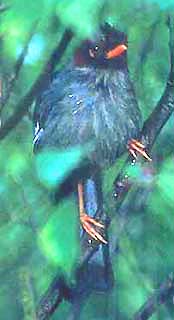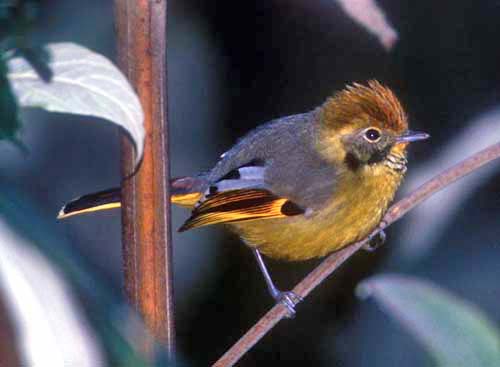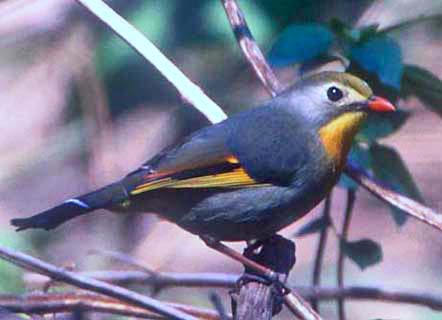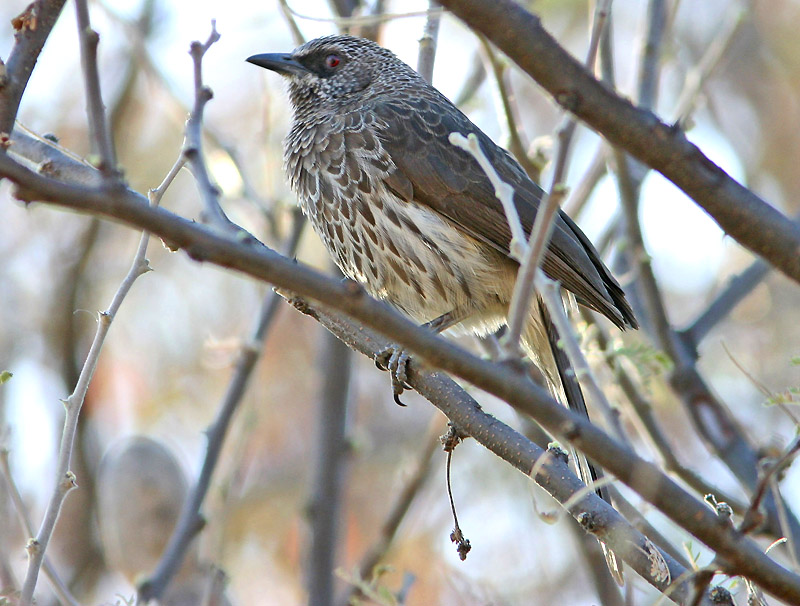
a web page by Don Roberson |
LAUGHINGTHRUSHES & ALLIES Leiothrichidae |
||
|
||
|
||
As a family, babblers were once considered to the "dustbin" of Old World avifauna, with many oddities thrown into the mix. Studies in the mid-2000s began to clarify the situation (e.g., Cibois 2003, Alström et al. 2006, Jønsson & Fjeldså 2006) but there was uncertainty whether the huge babbler assemblage should be allocated to one or two or more families. Genetic evidence revealed that the Sylvia warblers — the original genus in the 'Old World Warblers' Sylviidae — was more closely related to Babblers than other Old World Warblers [see a discussion of the break-up of the Old World Warblers]. More recent research, especially Gelang et al. (2009), have led to a "break-up of the Babblers." Cibois et al. (2010) summarized the outlines for five babbler families: tree babblers and scimitar-babblers [Timaliidae], sylvid babblers and parrotbills [Sylviidae], white-eyes [Zosteropidae], fulvettas and ground-babblers [Pellorneidae], and laughingthrushes [Leiothrichidae, this group]. The five-family solution has been adopted for some years, and I follow it here. [Note: later I split the parrotbills & allies as a family [Paradoxornithidae] and years later added the Alcippe Fulvettas [Alcippeidae].] The newly-designated Leiothrichidae is by far the largest family left among the babblers. About 66 species are called "laughingthrushes," in two genera: Garrulax (with 45 species) and Trochalopteron (with 21 species). Four species of Babax (genus Babax) look and behave like typical laughingthrushes. So, in all, about 70 species might be considered "laughingthrushes," and these comprise 30% of this family. They typically travel in small family groups or larger loose flocks, are often best found by vocalizations, and tend to be wary and secretive. Examples include Moustached Laughingthrush (below left), a secretive bird of bamboo forest in n. Burma and s. China, and Chestnut-capped Laughingthrush (below right), of montane forests of Malaya, Borneo, and Sumatra. |
||
|
||
This new family, though, includes quite a number of babblers that aren't at all similar to laughingthrushes. Some are tiny and colorful like the Chestnut-tailed Minla (left) beautifully photographed in n. India by Ron Saldino. They and other small babblers can be found in mixed species flocks or isolated pairs inside the forest. The Leiothrichidae now includes 3 species of Minla, 5 species of Liocichla, and 7 species of Barwing, plus 8 Sibia, two Crocias, and two Cutia, not to mention Capuchin Babbler Phyllanthus atripennis, White-throated Mountain Babbler Kupeornis gilberti, Red-collared Babbler K. rufocinctus, and Chapin's Babbler K. chapini. |
||
The "namesake" species for the new family is Red-billed Leiothrix (right in another shot from India by Ron Saldino). It is widespread in the Himalayan foothills, and has been introduced into Hawaii. Leiothrix and Turdoides were both formally proposed at the same time back in the 19th century, and either could have been the basis for this new subfamily name. Gelang et al. (2009) preferred Leiothrichinae. |
||
In contrast to the difficult forest babblers, 30 species (22% of all the Leiothrichidae) are open-country birds in the genus Turdoides. A few are marsh birds but most occur in open savanna or thornscrub where they travel in small noisy family parties, often leap-frogging each other as they move quickly from bush to bush so that the whole party appears to be "rolling" across the plain. The Jungle Babbler (left) is quite common in the dry forests of the Indian subcontinent; in Ranthambhor National Park it has become so tame that it searches the tourist's jeeps for tidbits. |
||
This group of Bare-cheeked Babbler (right) in Namibia were huddled together on one branch, a behavior I've also seen in other species of babbler in Tanzania and in northern China. A fair number of species forage together in loose family groupings. Thus the Turdoides babblers, like laughingthrushes, are very social birds. It is difficult to describe any of the five babbler families, because each has rich variation and diversity. Yet certainly Turdoides babblers and the 70 laughingthrushes share similarities that characterize much of this family. One more example is below: |
||
|
||
Photos: The Streaked Laughingthrush Trochalopteron lineatus was photographed at Sat Tal in northern India in March 2001. The White-browed Laughingthrush Garrulax sannio was at Huayang Village, Shaanxii, China, on 7 Nov 2010. The Moustached Laughingthrush Garrulax cineraceus was in Foping Nature Reserve, Shaanxii, China, on 11 Nov 2010. The Chestnut-capped Laughingthrush Garrulax mitratus was on Mt. Kinabalu, Sabah, Borneo, Malaysia, on 5 Aug 1988. Ron Saldino photographed the Chestnut-tailed Minla Minla strigula near Lava in w. Bengal, India, in late Feb 2001, and Ron photographed the Red-billed Leiothrix Leiothrix lutea near Corbett Nat'l Park, India, in mid-March 2001. The Jungle Babbler Turdoides striatus was in Ranthambhor Nat'l Park, Rajasthan, India, on 23 Mar 2001. The family of Bare-cheeked Babbler Turdoides gymnogenys was in Erusha Nat'l Park, Namibia, in July 2005. Hartlaub's Babbler Turdoides hartlaubii was photographed at N'Kwasa Camp, northern Namibia, on 22 July 2005. Ucredited photos © Don Roberson; credited photos © Ron Saldino, as credited and used with permission; all rights reserved. Bibliographic notes There is no recent "family book" covering the tree-babblers but good coverage of the various babbler families, including the current Leiothrichidae, is in Collar & Robson (2007). The account is wonderful, with exceptional photos, although it could not be quite up-to-date with the most current taxonomic findings., some of which post-date its publication. Literature cited:
|
 Babblers
were once considered a huge family of over 300 species of (mostly)
tropical forest birds in the Old World, but genetic evidence as led to
the "break-up of the babblers" into five families. A good chunk are
called laughingthrushes, and these, plus related genera, now are
combined to form a newly designated clade of babblers, here called the
Leiothrichidae. Many are rangy, mid-sized, floppy-tailed landbirds like Streaked Laughingthrush (left) of the Himalayan mid-elevations. Streaked Laughingthrush is easy
to observe as it forages in pairs in open rocky areas in the mountains;
its foraging behavior, its size, and the fact one finds it mostly in
closely-knit pairs all resemble the California Towhees Melozone crissalis in my home county.
Babblers
were once considered a huge family of over 300 species of (mostly)
tropical forest birds in the Old World, but genetic evidence as led to
the "break-up of the babblers" into five families. A good chunk are
called laughingthrushes, and these, plus related genera, now are
combined to form a newly designated clade of babblers, here called the
Leiothrichidae. Many are rangy, mid-sized, floppy-tailed landbirds like Streaked Laughingthrush (left) of the Himalayan mid-elevations. Streaked Laughingthrush is easy
to observe as it forages in pairs in open rocky areas in the mountains;
its foraging behavior, its size, and the fact one finds it mostly in
closely-knit pairs all resemble the California Towhees Melozone crissalis in my home county. Many other laughingthrushes, though, are elusive
species in thick jungle, best located by voice. On a multi-week trip to
India, for example, we heard noisy flocks of the striking and
widespread White-crested Laughingthrush Garrulax leucolophus several times — sometimes quite close — and yet Rita and I only saw
them on our next-to-final day and then only in flight across a small
densely vegetated canyon. All the other times it sounded like they were
laughing at us! Noisy flocks of White-browed Laughingthrush in central China were not quite so secretive — I even managed a photo! (right).
Many other laughingthrushes, though, are elusive
species in thick jungle, best located by voice. On a multi-week trip to
India, for example, we heard noisy flocks of the striking and
widespread White-crested Laughingthrush Garrulax leucolophus several times — sometimes quite close — and yet Rita and I only saw
them on our next-to-final day and then only in flight across a small
densely vegetated canyon. All the other times it sounded like they were
laughing at us! Noisy flocks of White-browed Laughingthrush in central China were not quite so secretive — I even managed a photo! (right). 




 While Asia is the center of babbler
distribution, members of the Leiothrichidae also occur in Africa. These include 14 of the Turdoides babblers.
While Asia is the center of babbler
distribution, members of the Leiothrichidae also occur in Africa. These include 14 of the Turdoides babblers.